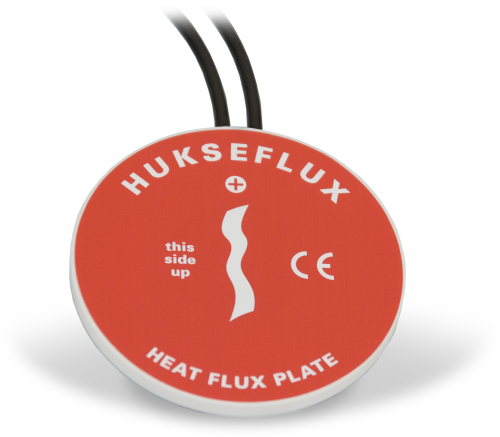
Selbstkalibrierend, ideal für Energiebilanzmessungen in Eddie-Kovarianz- und Bowen-Ratio-Systemen






Überblick
Die HFP01SC misst den Bodenwärmestrom, normalerweise für Energiebilanz- oder Bowen-Ratio-Systeme. Sie ist für Anwendungen gedacht, bei denen höchste Genauigkeit wichtig ist. Mindestens zwei Sensoren sind an einer Station notwendig, um einen Durchschnitt zu bilden. Messstellen mit heterogenen Böden brauchen unter Umständen weitere Sensoren.
Lesen Sie mehr
Funktionen und Vorteile
- Corrects for errors due to differences in thermal conductivity between the sensor and surrounding medium, temperature variations, and slight sensor instabilities
- Compatible with most Campbell Scientific data loggers
- Uses Van den Bos-Hoeksma self-calibration method to provide a high degree of measurement accuracy
Bilder



Technische Beschreibung
The HFP01SC consists of a thermopile and a film heater. The thermopile measures temperature gradients across the plate. During the in-situ field calibration, the film heater is used to generate a heat flux through the plate. The amount of power used to generate the calibration heat flux is measured by the datalogger. Each plate is individually calibrated, at the factory, to output flux.
Self-calibration corrects for errors due to differences in thermal conductivity between the sensor and surrounding medium, temperature variations, and slight sensor instabilities.
Spezifikationen
| Sensor Type | Thermopile with film heater |
| Sensitivity | 50 μV W-1 m-2 (nominal) |
| Nominal Resistance | 2 Ω |
| Temperature Range | -30° to +70°C |
| Expected Typical Accuracy | ±3% of reading |
| Heater Resistance | 100 Ω (nominal) |
| Heater Voltage Input | 9 to 15 Vdc |
| Heater Voltage Output | 0 to 2 Vdc |
| Duration of Calibration | ±3 minutes @ 1.5 W (typically performed every 3 to 6 hours) |
| Average Power Consumption | 0.02 to 0.04 W |
| Plate Diameter | 80 mm (3.15 in.) |
| Plate Thickness | 5 mm (0.20 in.) |
| Weight | 200 g (7.05 oz) without cable |
Dokumente
Realisierte Projekte
Downloads
CR1000X HFP01SC Example program v.2 (3 kb) 18-02-2020
CR1000X program that measures the HFP01SC, performs the self-calibration, and checks for calibration validity. Refer to the manual for the equations used for the self-calibration and calibration-validity checks. A table in the manual provides a cross reference of the terms in the equations in the manual with the constants and variables in the example data logger program.
FAQs für
Number of FAQs related to HFP01SC-L: 9
Alle anzeigenWenige anzeigen
-
Can the HFP01SC-L be embedded in railroad ballast, which comprises a blend of coarse rock particles?
No. The HFP01SC-L must be in full contact with the media. Railroad ballast is too coarse.
-
The example CRBasic program runs in either SequentialMode or PipeLineMode. To force the CRBasic program to run in PipeLineMode, add the instruction PipeLineMode to the beginning of the program.
-
Rather than using a running average to find the millivolt output during a calibration, use a single sample with 50 or 60 Hz integration. See Example 1 in the 2014 or later version of the HFP01SC-L manual.
-
A calibration shift occurs if the HFP01SC-L is not making full contact with the soil during the calibration cycle. The following could cause the plate to lose contact with the soil: a soil freeze/thaw cycle, soil swelling/contracting because of extreme drying/wetting cycles, or rodents burrowing past the plate.
-
The in-situ calibration is helpful for quality assurance/quality control. The multiplier determined from the in-situ calibration should be within ±10% of the factory-determined calibration. If it is not, the plate may be damaged, not wired correctly to the data logger, or not making full contact with the soil.
-
Because of the loss of IR radiation, nearly all thermopile instruments typically have a negative offset. This offset is most easily visible at night-time, when a small negative value is read instead of zero. This same offset is present during the daytime, but it is not as visible because of the large solar signal.
Another common issue involves leveling an instrument. Leveling a thermopile instrument can cause errors in the direct beam component because the cosine response is not correct. These errors are more notable when the sun is close to the horizon because the angle is so shallow.
-
The information included on a calibration sheet differs with each sensor. For some sensors, the sheet contains coefficients necessary to program a datalogger. For other sensors, the calibration sheet is a pass/fail report.
-
Add the appropriate code to the data logger program using a program example from the HFP01SC-L manual. Alternatively, contact Campbell Scientific for assistance.
Anwendungsbeispiele
Overview In the fight against climate change, innovative solutions are emerging to address the global challenge......lesen Sie mehr
The Austin College Weather Station (ACWX) is located on Austin College's Sneed Environmental Research Area,......lesen Sie mehr



